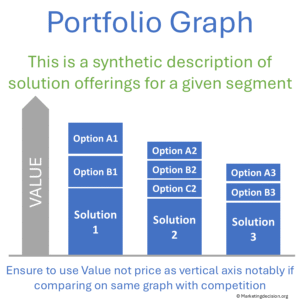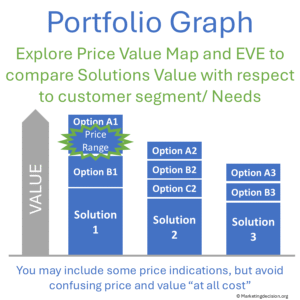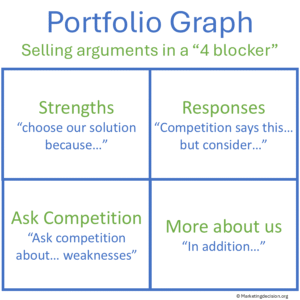A portfolio graph is a tool that displays solutions from the company—and sometimes from competitors—along a vertical axis representing the relative value of each solution. Different graphs are created for different market segments, where perceived value varies, and offerings are listed to highlight positioning and sales tactics.
 This approach emphasizes value mapping. By comparing the relative values of solutions, the goal is to facilitate discussions on how each solution’s value and positioning should be addressed, both within the company’s offerings and against competitors. While price ranges can be mentioned on the graph, the vertical axis should focus on perceived value, not price, to ensure discussions stay centered on value.
This approach emphasizes value mapping. By comparing the relative values of solutions, the goal is to facilitate discussions on how each solution’s value and positioning should be addressed, both within the company’s offerings and against competitors. While price ranges can be mentioned on the graph, the vertical axis should focus on perceived value, not price, to ensure discussions stay centered on value.
This tool is particularly effective for marketing to demonstrate how company solutions compete with those of competitors in various market segments. It enables collaborative discussions between Marketing and Sales teams on sales arguments and positioning strategies.
Presenting solutions and configurations with a focus on positioning, by comparing products against one another, is typically handled by marketing. This process helps sales and marketing teams align on strategy and product positioning during regular meetings. Additionally, it provides an opportunity to discuss sales offerings, identify gaps in the product line, and adjust pricing and go-to-market strategies when needed.
By outlining product offerings, teams can visualize both their own and competitors’ solutions, helping them determine the right sales tactics for each segment.
While the portfolio graph may seem simple, it must be used carefully. It is a valuable tool for ongoing discussions between sales and marketing teams to review positioning. More sophisticated tools, like price-value mapping, allow teams to assess relative positioning based on both value and price. However, the portfolio graph offers a straightforward way to communicate product positioning effectively.
The vertical axis reflects the relative value of solutions as perceived by customers in a specific segment. This helps explain the rationale behind the positioning. It is essential to note that the axis is not based on price, as prices can fluctuate in various deal situations. By focusing on the value dimension, teams can direct discussions toward differentiating from competitors and winning deals. While price ranges can be indicated, they should not be used to define the vertical axis.
For price discussions, it is more appropriate to use a Price vs. Value map, which explores the relationship between price and perceived value.
 Avoid the temptation to use the vertical axis as a price axis. Doing so sends the wrong message, implying that price determines positioning. Instead, focus on perceived value, as this is the key factor. The more value a solution demonstrates, the higher the price it can command.
Avoid the temptation to use the vertical axis as a price axis. Doing so sends the wrong message, implying that price determines positioning. Instead, focus on perceived value, as this is the key factor. The more value a solution demonstrates, the higher the price it can command.
Marketing and sales meetings that focus heavily on price often turn into pricing discussions. To prevent this, encourage value-centered conversations, where price is mentioned only as a secondary factor, such as through a price range noted alongside the solution, but not used as the primary basis for ranking company and competitor solutions.
The method closely follows the approach used for evaluating the value axis in the Price vs. Value map. Leverage market knowledge, Voice of the Customer (VOC) insights, and customer feedback to assess perceived value for each segment. Refer to these data sources to inform your decisions.
In regular team meetings, review the value-setting approach. If sales teams disagree with the proposed positioning, explore the reason behind their concerns. This feedback might signal a need for new sales tactics or point to competitors introducing new solutions.
 Regularly update the graphs, and use sales meetings to share these updates. Incorporate sales arguments to answer key questions, such as:
Regularly update the graphs, and use sales meetings to share these updates. Incorporate sales arguments to answer key questions, such as:
The aim is to show that your solution is the best choice, considering the budget, customer needs, and market segment—without misrepresenting your competitors. Focus on highlighting your strengths and how they differentiate your offerings, while addressing competitors’ weaknesses where appropriate.
The portfolio graph provides a simple yet effective way to share product positioning across sales and marketing teams and discuss future solutions. While its simplicity aids communication, it may also be a limitation. Other tools, like Price vs. Value mapping, should be used to further review and validate offerings for each segment.
Be careful not to confuse the value dimension with price. This tool is designed to focus on solution positioning, not pricing. To ensure sales success, develop a unique pitch for each segment and solution.
© marketingdecision.org
The following section may include tools, some free, some with a fee to support this site development. If you consider a tool should be presented in this section and is missing, please let us know at: contact@marketingdecision.org
© 2025 MARKETING DECISION SOLUTIONS. All Rights Reserved.